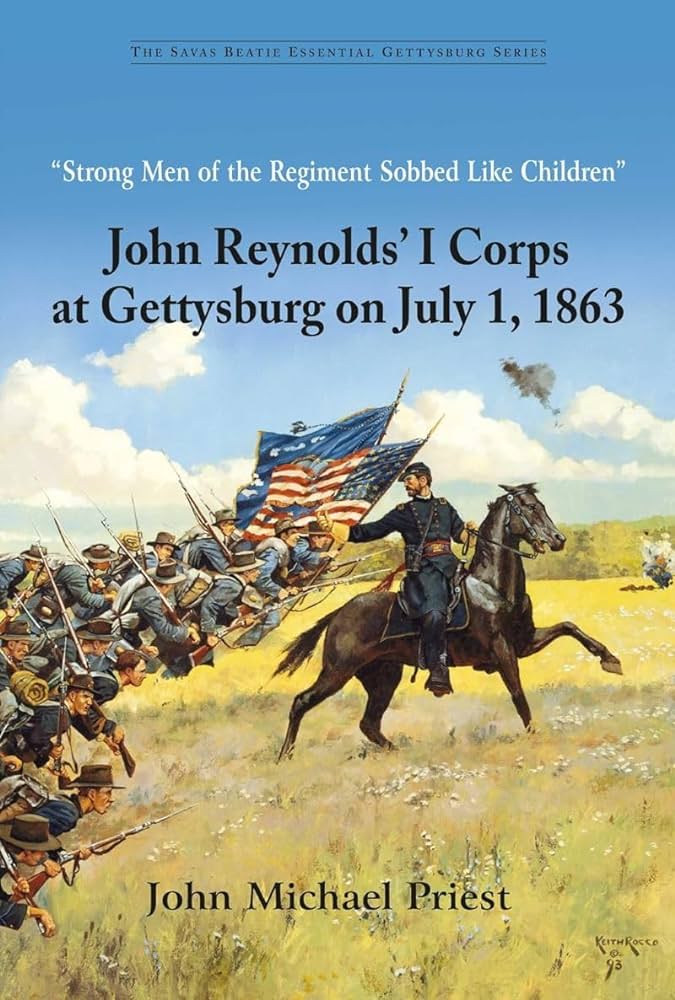Book Review: “Strong Men of the Regiment Sobbed Like Children”: John Reynolds’ I Corps at Gettysburg on July 1, 1863

 “Strong Men of the Regiment Sobbed Like Children”: John Reynolds’ I Corps at Gettysburg on July 1, 1863. By John Michael Priest. Eldorado Hills, CA: Savas Beatie, 2024. Hardcover, 417 pp. $37.50.
“Strong Men of the Regiment Sobbed Like Children”: John Reynolds’ I Corps at Gettysburg on July 1, 1863. By John Michael Priest. Eldorado Hills, CA: Savas Beatie, 2024. Hardcover, 417 pp. $37.50.
Reviewed by Brian Swartz
With his new book “Strong Men of the Regiment Sobbed Like Children:” John Reynolds’ I Corps at Gettysburg on July 1, 1863, historian and author John Michael Priest brings to vivid reality the chaos, combat, heroism, and hurting that engulfed the Army of the Potomac’s I Corps west of Gettysburg on that bloody Wednesday.
Priest sets the stage with chapter 1 (“First Contact: June 29 to 30, 1863”), then chronologically develops I Corps’ Gotterdammerung through the next 12 chapters and the short aftermath. Tying in the Yankee cavalry and Union and Confederate artillery and infantry involved in the day’s fighting, he weaves such a compelling tale of non-stop action and combat that by the last page, the reader might feel like an I Corps’ survivor stumbling into Union lines atop Cemetery Hill at day’s end and wondering how anyone survived the carnage that “thoroughly wrecked” John Reynolds’ command. (374)
Priest introduces the generals and colonels well- and lesser-known, Union and Confederate. They’re not the main part of the story, however. Priest utilizes both local residents (including women) and ordinary soldiers to tell most of the tale; doing so makes I Corps’ debacle much more personal from the perspectives of Yankees, Johnnies, and civilians alike. From obscure regimental commanders to soldiers and civilians appearing in period sources long since filed away, Priest connects the reader with many, many people involved in what happened to I Corps.
His method for introducing uniformed combatants seems initially confusing. The first example, “Lt. William E. Kyle (Company B, 52nd North Carolina),” typifies how Priest connects the soldiers with their units, especially on first reference. The reader soon realizes that among other reasons, Priest does so to clarify what specific units and their members are doing at particular times. (2)
The book excels in its chronology, broken down in places to 10- or 15-minute increments. Checking and cross-checking his primary sources (300, according to the jacket cover) and later sources, Priest sometimes relates different events taking place at different locations within the same timeframe. Clear section breaks prevent the reader from getting confused in such situations.
Apparently, Priest’s research involved walking the terrain and measuring distances at various places. He doesn’t directly say that he’s done so, but he sometimes cites specific distances, and his terrain descriptions are those of someone who’s been there, seen that, and explored it. The reader benefits as Priest describes obscure battlefield features unfamiliar to many Gettysburg buffs.
Returning to those soldier/unit references: As July 1 unfolds and units get shot to pieces, the soldiers and their fates reveal combat’s intensity, horror, pathos, and cost. Via the soldiers he introduces, Priest takes the reader through fire and hell as I Corps fights almost to the death.
Priest extensively researched the book, as his copious sources and footnotes indicate. He is a researcher who, with assistance from “some very gifted and generous historians and Civil War enthusiasts,” dug into the historical weeds and down to their roots to find the soldiers and civilians caught up in I Corps’ combat. (x)
One minor flaw is visual in nature. While the footnotes are placed on the citations’ respective pages—a boon to footnote fans—the footnotes sometimes run long (see page 220, for example), which can visually disrupt the reader’s concentration. After all, how can a Gettysburg buff not want to check the footnotes before moving on to the next page? Additionally, although the book contains nineteen maps detailing unit locations (and sometimes movements) at particular times on July 1, a few more maps located where combat intensifies from late morning to midafternoon would have been helpful.
“Strong Men of the Regiment Sobbed Like Children”: John Reynolds’ I Corps at Gettysburg on July 1, 1863, is an excellent addition to Gettysburg historiography. It is definitely a resource upon which current and future historians and authors will use widely.
Thank you for the excellent review. I genuinely appreciate it. Mike Priest
Sounds like a good job, well done. I look forward to reading it. Thanks, Mike!
I appreciate the compliment.
Years ago I enjoyed a trip to South Mountain and Antietam that included Mike Priest as a guide. I remember his enthusiasm and depth of knowledge. I can see how he would infuse these into his book.
Thank you for the wonderful compliment. Mike Priest